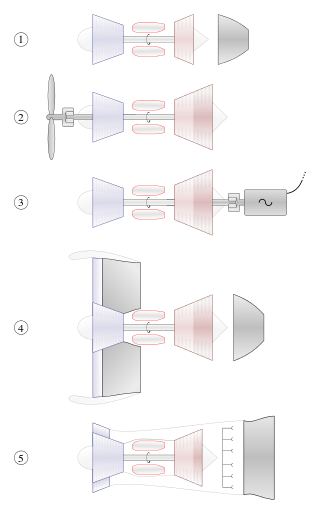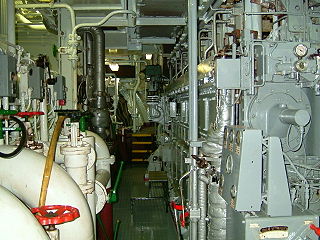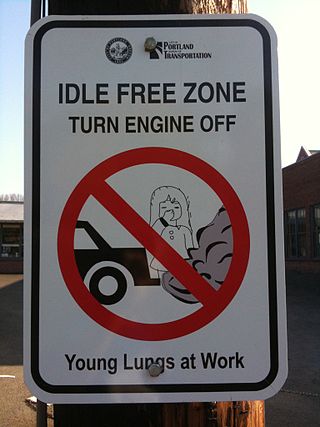
An electric boat is a powered watercraft driven by electric motors, which are powered by either on-board battery packs, solar panels or generators.

A gas turbine or gas turbine engine, by its old name internal combustion turbine, is a type of continuous flow internal combustion engine. The main parts common to all gas turbine engines form the power-producing part and are, in the direction of flow:

An auxiliary power unit (APU) is a device on a vehicle that provides energy for functions other than propulsion. They are commonly found on large aircraft and naval ships as well as some large land vehicles. Aircraft APUs generally produce 115 V AC voltage at 400 Hz, to run the electrical systems of the aircraft; others can produce 28 V DC voltage. APUs can provide power through single or three-phase systems.

A hybrid vehicle is one that uses two or more distinct types of power, such as submarines that use diesel when surfaced and batteries when submerged. Other means to store energy include pressurized fluid in hydraulic hybrids.

A diesel locomotive is a type of railway locomotive in which the power source is a diesel engine. Several types of diesel locomotives have been developed, differing mainly in the means by which mechanical power is conveyed to the driving wheels. The most common are diesel-electric locomotives and diesel-hydraulic.

An icebreaker is a special-purpose ship or boat designed to move and navigate through ice-covered waters, and provide safe waterways for other boats and ships. Although the term usually refers to ice-breaking ships, it may also refer to smaller vessels, such as the icebreaking boats that were once used on the canals of the United Kingdom.

On a ship, the engine room (ER) is the compartment where the machinery for marine propulsion is located. The engine room is generally the largest physical compartment of the machinery space. It houses the vessel's prime mover, usually some variations of a heat engine. On some ships, there may be more than one engine room, such as forward and aft, or port or starboard engine rooms, or may be simply numbered. To increase a vessel's safety and chances of surviving damage, the machinery necessary for the ship's operation may be segregated into various spaces.
Mild hybrids (MHEV) are generally cars with an internal combustion engine (ICE) equipped with a negligibly bigger electric combined motor and generator in a parallel hybrid configuration allowing the engine to be turned off whenever the car is coasting, braking, or stopped, and then quickly restarted once power is again required. Mild hybrids may employ regenerative braking and some level of power assist to the internal combustion engine, but mild hybrids do not have an electric-only mode of propulsion.
Hybrid vehicle drivetrains transmit power to the driving wheels for hybrid vehicles. A hybrid vehicle has multiple forms of motive power.

Marine propulsion is the mechanism or system used to generate thrust to move a watercraft through water. While paddles and sails are still used on some smaller boats, most modern ships are propelled by mechanical systems consisting of an electric motor or internal combustion engine driving a propeller, or less frequently, in pump-jets, an impeller. Marine engineering is the discipline concerned with the engineering design process of marine propulsion systems.

Idle reduction describes technologies and practices that minimize the amount of time drivers idle their engines. Avoiding idling time has a multitude of benefits including: savings in fuel and maintenance costs, extending vehicle life, and reducing damaging emissions. An idling engine consumes only enough power to keep itself and its accessories running, therefore, producing no usable power to the drive train.

ISE Corporation was a manufacturer and integrator of heavy-duty hybrid electric powertrain systems for transit bus and truck use, based in San Diego and later Poway, California. ISE was founded in 1995 and filed for bankruptcy in 2010, shortly after raising $20 million in its initial public offering on the Toronto Stock Exchange.

Cold ironing, or shore connection, shore-to-ship power (SSP) or alternative maritime power (AMP), is the process of providing shoreside electrical power to a ship at berth while its main and auxiliary engines are turned off. Cold ironing permits emergency equipment, refrigeration, cooling, heating, lighting and other equipment to receive continuous electrical power while the ship loads or unloads its cargo. Shorepower is a general term to describe supply of electric power to ships, small craft, aircraft and road vehicles while stationary.
Voltec, formerly known as E-Flex, is a General Motors powertrain released in November 2010. The Voltec architecture is primarily a plug-in capable, battery-dominant electric vehicle with additional fossil fuel powered series and parallel hybrid capabilities.

A range extender is a fuel-based auxiliary power unit (APU) that extends the range of a battery electric vehicle by driving an electric generator that charges the vehicle's battery. This arrangement is known as a series hybrid drivetrain. The most commonly used range extenders are internal combustion engines, but fuel-cells or other engine types can be used.
IdleAir, a division of Convoy Solutions LLC, is a company that provides in-cab services to truckers via centralized systems at truck stops around the United States. IdleAir's service, the patented Advanced Travel Center electrification (ATE), was more complex and more expensive than traditional truck stop electrification (TSE) systems which are aimed at idle reduction reducing the amount of fuel consumed by trucks while they idle during rests.

Many variations of aircraft engine starting have been used since the Wright brothers made their first powered flight in 1903. The methods used have been designed for weight saving, simplicity of operation and reliability. Early piston engines were started by hand. Geared hand starting, electrical and cartridge-operated systems for larger engines were developed between the First and Second World Wars.

An internal combustion engine is a heat engine in which the combustion of a fuel occurs with an oxidizer in a combustion chamber that is an integral part of the working fluid flow circuit. In an internal combustion engine, the expansion of the high-temperature and high-pressure gases produced by combustion applies direct force to some component of the engine. The force is typically applied to pistons, turbine blades, a rotor, or a nozzle. This force moves the component over a distance, transforming chemical energy into kinetic energy which is used to propel, move or power whatever the engine is attached to.

The South African Railways gas-electric locomotive of 1923 was an experimental gas-electric locomotive. The fuel, suction gas, was generated on-board the locomotive from coal.

Sisu was a Finnish state-owned icebreaker. Built in 1939 at Wärtsilä Hietalahti Shipyard in Helsinki, she was one of the world's first diesel-electric icebreakers. In addition to icebreaking duties, she served as a submarine tender for the Finnish Navy during the summer months until the end of the Continuation War.

















